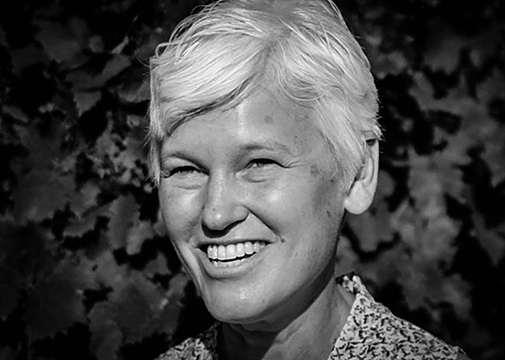
Arrowhead Spring is located on the New York side of the Niagara Escarpment - a wine region where the Canadians seem to be getting all the attention. Recently Eric Asimov in the New York Times wrote in praise of the of Niagara Escarpment, though his column focused on the Canadian side: "The Niagara Peninsula is more than hospitable to cool-climate varieties like riesling, chardonnay and pinot noir. Surprisingly, grapes that require a longer growing season, like cabernet franc, also make exceptional wines."
The Niagara Escarpment, an uplift of bedrock that runs parallel to Lake Ontario in Niagara County, is a unique geological feature that influences the winegrowing in the region. Lake Ontario also provides a lake effect that allows protection against frost. Surprisingly, Niagara is the second warmest grape growing region in New York State.
At Arrowhead Spring they grow Merlot, Syrah, Cabernet Sauvignon, Chardonnay, Pinot Noir and Cabernet Franc and have recently planted Tempranillo. In the vineyard they focus on sustainable farming practices, growing grapes without the use of pesticide or herbicide. Much of the wine in Niagara on the New York side of the border is on the sweeter side and aimed at tourists visiting The Falls. Arrowhead Spring has been a key force in pushing the region towards a quality approach and towards dryer styles of wines.
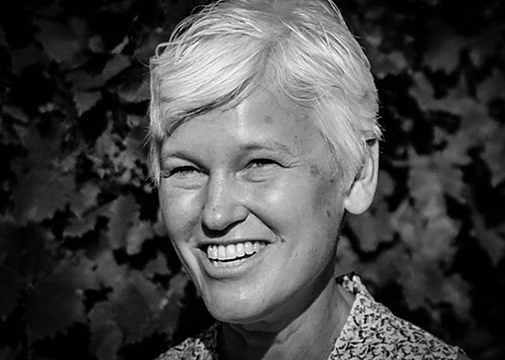 Grape Collective talks with owner Robin Ross about the unique wines being made in the Niagara region.
Grape Collective talks with owner Robin Ross about the unique wines being made in the Niagara region.
Christopher Barnes: Robin, how did you get involved with wine?
Robin Ross: This was a longtime dream of my husband, Duncan, who has been a wine fan forever and made wine long before I knew him. He decided at one point, after we were married, to let me know that his dream was to someday open a winery.
After we retired we knew we were going to do this, but since I came from a farming background, I knew that it was a lot of hard, physical labor. So at one point, I just said, "Hey, if we're going to do this, let's just do this now." So we jumped in.
And Niagara is an interesting region in terms of wine. How has the wine region evolved in Niagara?
So the evolution of wines in the region is an interesting story. We had wineries here prior to Prohibition on a small scale, and post-Prohibition as well, with a winery that focused on making sparkling wines down by the Artpark area of Lewiston, and later out on Route 104, Lewiston.
That winery closed in the late '70s, early '80s, and there really wasn't anything in our region again until the late '90s. All of the sudden, it's blossomed from there. There has been a focus in the area with vinifera, but it's been small and in a growing focus, we find that certain clones and certain varietals grow quite well here. I particularly am fond of Cabernet Franc, even though it's a late ripener, but we do have a long growing season. Actually, the second longest in New York state.
Pinot Noir is another great one for our region, because we can depend on it to ripen every year, and it is winter-hardy. In spite of what people think about western New York winters, it's really not so bad. I grow nine different varietals of grapes, eight of which are vinifera.
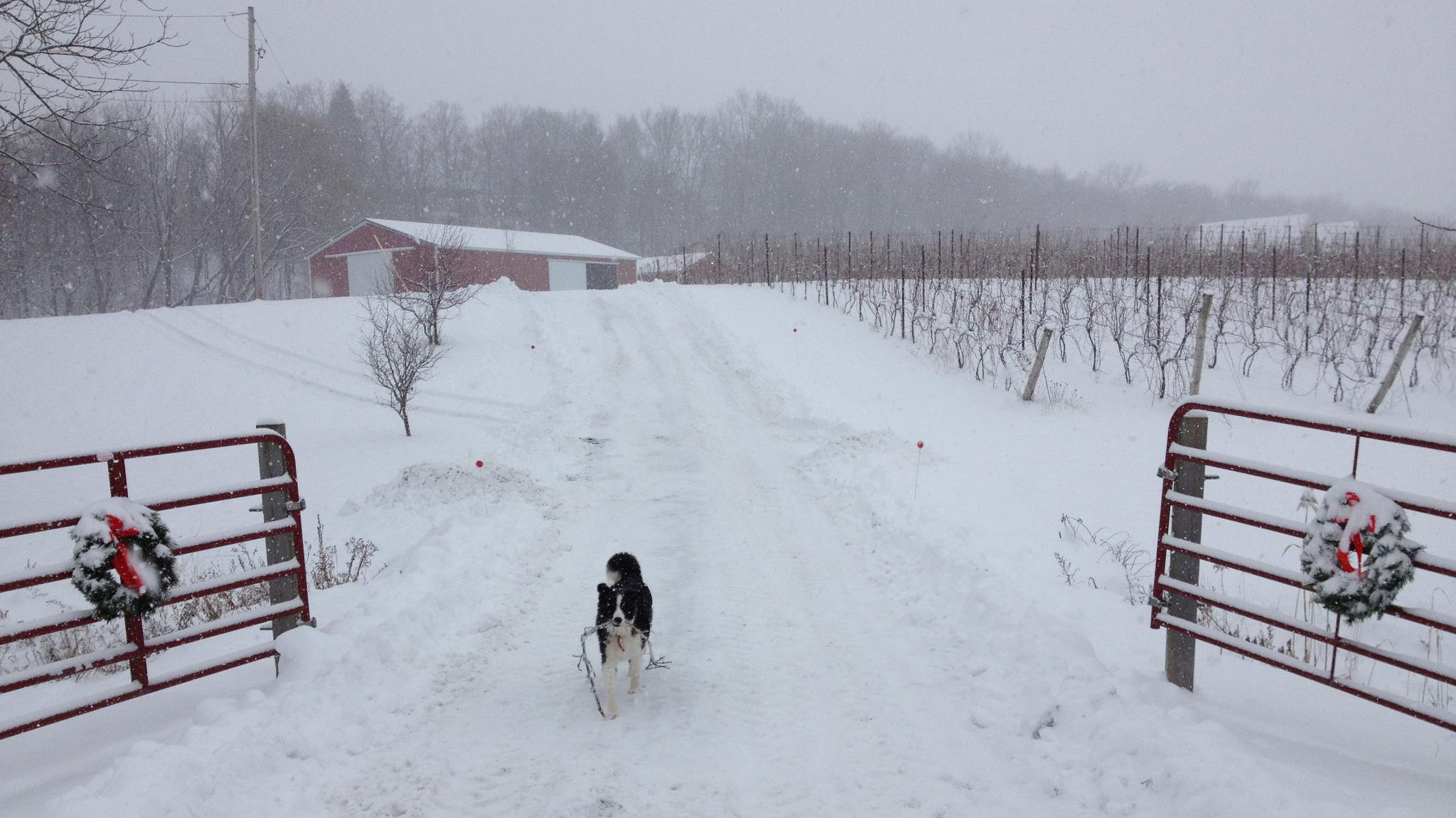
Talk a little bit about the terroir here.
The terroir of our region is interesting. If you were standing where I'm standing approximately 10,000 years ago, we'd be underwater. This was part of a large lake that eventually, as glaciers moved out, receded. We got the fresh water lakes that we now have, the closest one being Lake Ontario out to the north of me.
The other geological formation, which is important to our region, is the escarpment, which is to the south of me. That formation, of course, includes Niagara Falls and stretches approximately 650 miles, all the way out to Wisconsin. But our little area of the Niagara Escarpment is a specific area with locations in reference to Lake Ontario, and a certain number of feet above sea level, and the Niagara Escarpment itself.
The soils here, because of the formations, are dolomitic limestone, which is quite nice for growing grapes. Every terroir probably has a wonderful impact on grapes, but our flavors are really impacted by the dolomitic limestone that's in the area. As far as how that helps our growing season, the formations of the land themselves, Lake Ontario is a large heat sink. It's to the north of me, and it's approximately 600 feet deep and 30 miles across, up in this area. That means it never freezes over. So in the winter, it mitigates the freezing temperatures that come as we get winds blowing across from the west. That helps our vinifera to survive the winters.
The other thing it does is the warm air is rising off the lake, warmer than the temperatures of the wind coming across the lake. As it rises up, it comes back and hits the escarpment and then rolls down. We get some nice air movement, keeping us slightly warmer than perhaps five or 10 miles south, where we can notice a differential of as much as 11 degrees in the wintertime.
In the spring, because we're up on the escarpment, we get the kind of opposite effect. We have an earlier spring and bud break than down at the lake. However, for frost mitigation, the airs are always moving. Because of this change of temperature between cold air masses and the warm air masses, the air travels down the hillside. That air movement is what provides us some sort of frost protection for our vines, so that when we go through budding, we're not losing a lot due to frost.
In the years since we've grown grapes here, we haven't had any loss due to frost, and I've had vineyards planted here since 2006. So that's been really great for us. We have a long growing season as well. The Cabernet Franc I'm standing next to, generally speaking, I don't harvest this till November 4th or 5th. We still have full leaf in the vineyard, which is nice because we have all these extra weeks of fall to bring these grapes up to a ripe temperature. I know if I try one right now, they're just not there yet. The seeds are still a little bit green.
It's been a tough year for ripening. We've had a little bit of a cooler than normal summer, but for the last two weeks we've had nothing but straight sunshine and hot weather. That's the kind of thing we get most falls here in the Niagara Escarpment region, and that always seems to save us and get our grapes to full ripening before we have to harvest.
** A happy update to this – we had a long, warm, sunny, dry autumn and everything ripened beautifully!!!
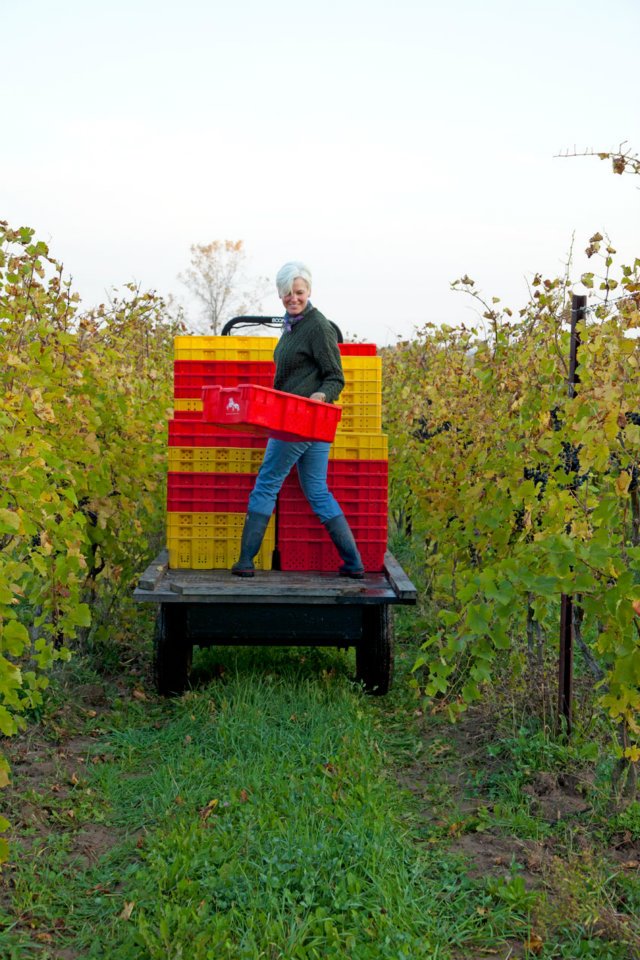 How is the New York Niagara region different from the Canadian Niagara region?
How is the New York Niagara region different from the Canadian Niagara region?
So right across the border from us is the Canadian Niagara Escarpment region. We're often asked how it is any different or the same as the New York region. Actually from a growing standpoint, it's very similar. Grapes don't know any political boundaries. We're growing in the same thing. Both sides have an escarpment, and they have the lake.
We have a little bit more of a lake impact here, just because there's more of the shoreline to the north of me than there is as the Canadian region stretches out. So we might have a little bit stronger or longer of a growing season than some of the wineries on the other side of the river. But as far as climate goes, it's more or less the same. In fact, we've taken advantage of a lot of the research that was done on the Canadian side of the border through Brock University, to learn about what grapes would grow best here on our specific plot of land.
Talk a little bit about the vinifera that grow here. Are there grapes that, first of all, you love? Are there grapes that you are surprised that do well?
So we grow almost all vinifera here. The vineyard that I'm standing in has Merlot, Cabernet Sauvignon, Cabernet Franc, Syrah, and Chardonnay. We did, at one time, have a planting of Malbec. All of those grew well here. I had to pull the Malbec out. Unfortunately, it had a virus in that clone and it's a little bit of a problem now. You must buy disease-free material when you're planting a vineyard. But they all seem to grow here.
I was a little bit surprised and concerned about Merlot, to be honest. I put it in the nicest part of the soils of the vineyard. Mostly my concern was that it was a little bit more cold-sensitive than the other varietals that we grow. But surprisingly, even in the very bitter cold winters of 2014, we lost, I would say, less than five percent of the plants to cold damage.
Honestly, when I lose a vine in the vineyard, it is caused by tractor blight, which is when we come through with the machinery and nick it. We don't use herbicide in our vineyard, so since we're doing under-canopy tillage and mowing, there is occasionally an incident where a piece of equipment, if you're not perfectly centered in a row, might perhaps damage a vine as we're trying to get them in their most healthy condition for the harvest season.
Talk a little bit about your philosophy of winemaking and viticulture.
I would say that we really love dry reds and barrel-aged reds in a French wine style. We like to produce wines that have a nice vibrant acidity and are great for food pairings. We're a really a food-oriented family, I suppose, and food-oriented culture. It's important for us that our wine is very food-friendly.
We age all our reds in barrel anywhere from one year to just over two years, depending on the particular varietal. For some of them, like Pinot Noir, we found that having just a year of impact of the oak onto the wine is sufficient. But for other things like Cabernet Franc and Cabernet Sauvignon, they seem to really benefit from a longer barrel-aging program.
How about the viticulture?
We started out thinking about being biodynamic or organic, but we are really what I would call sustainable. The idea is that we want to have vines growing in a manner that's healthy for the environment and the soils, while at the same time being healthy for the farm operation as a whole.
We don't use herbicide anywhere on the vineyard. The posts that we use in the vineyard are either steel or locust, so that we don't have any impact from CCAs coming out of pressure-treated wood. We keep a cover crop so we don't have to worry about having soil erosion in our vineyards, and also because the soil underneath the cover crop tends to be healthier. There are bacteria and microbes and things that live in the soil and they require nourishment from plants on the surface. So once the grasses that we grow and the clover, etc., is mowed down, it feeds into the soil and it also dissipates nutrition to the vine, so that we don't have to add additional nutrients besides the compost that we put on every year.
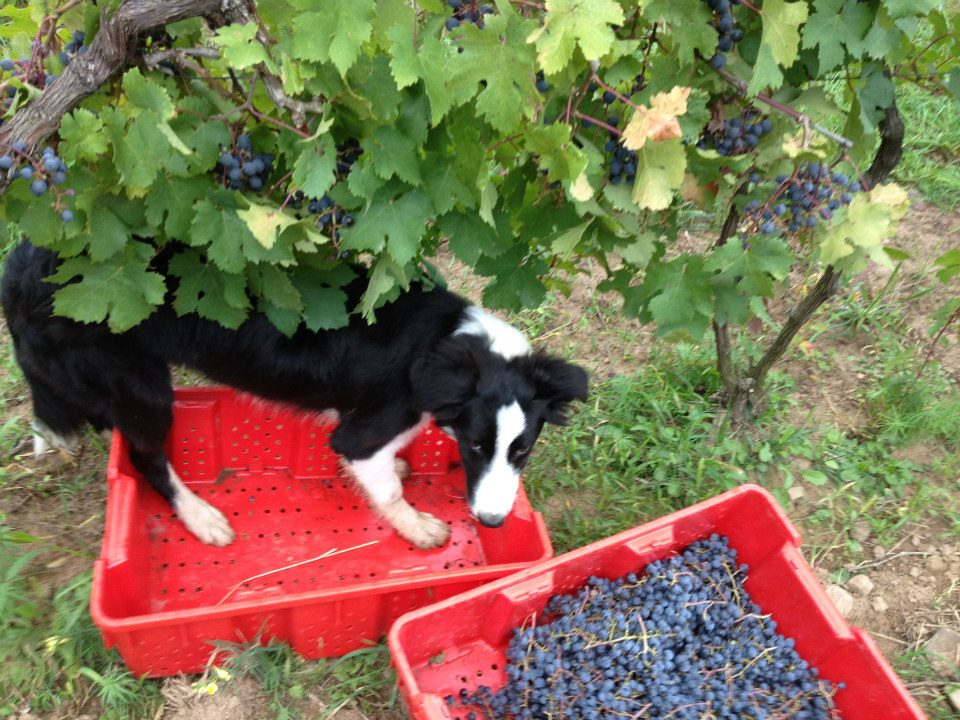
(Ian, photo left, is always on hand to help with the harvest)
We do compost all of our materials that come out of the winemaking process. For example, the skins, the seeds, the stems, and in the vineyard, when we do our pruning in the winter, we just throw all of our prune clippings into the center of the aisles. We come through with a flail mower to cut them up, so that we're not taking too much nutrient-dense material, other than the grapes, out of the vineyard. Even with the grapes, again we're adding the skins and the seeds back in.
This is what we're trying to do to grow a very healthy vine, but also to keep our area and our soils healthy, there's a lot of different life forms that depend on that; a lot of different insect life, for example. We've also found that this seems to make it easier to maintain the grapes' health. We haven't had a big issue with insects ever, with the exception of the Japanese beetle that doesn't really have any native species to eliminate it. For a while, we were using our chickens that we keep on-site to get rid of beetles. This involved walking a whole flock of chickens through the vineyard every morning and shaking the vines. The beetles would fall and the chickens would eat them. Actually, it works great, but it's gotten to be a little bit harder when we're doing just say, seven acres of vines, that was one thing. But now we have over 22 planted that we maintain and it's become quite another job to walk chickens through.
What do you think the New York Niagara wine region has to do to become part of the same conversation that say the Finger Lakes is, or Long Island is, in terms of New York wines?
One thing we need to learn to do is to market ourselves a little bit better and to get our wines out there into publications like The Wine Spectator or Wine Enthusiast that people in the industry read to learn about great wines.
Another thing I think that our region needs to get a stronger focus on, vinifera. We need to get more vinifera planted up here, more people growing it, more people making wine out of it, because the standard wines that we've all been accustomed to in our culture for, really, hundreds of years, seem to be vinifera-based. It would be a great idea to grow more here, since we have beautiful growing conditions for vinifera.
How has winemaking changed in the region since you've started here?
We're seeing more wineries open with the vinifera focus in our area. But the methodologies used in bringing the grapes into wine are honestly things that have been used for hundreds of years. The wineries that are focusing on vinifera have barrel-aging programs. Some people believe in using natural yeast, some people believe in fermenting with purchased yeast, but in the end, when you live in a wine region, I suppose even the natural yeast is honestly purchased yeast that some other winery chose, because the spores of course, are going to be in the air around us.
But the winemaking techniques are those that have been used, really, in winemaking for a number of years. Perhaps the equipment is a lot easier than it was a couple hundred years ago. We have pumps to help us out and larger equipment to harvest grapes, etc., but other than that, winemaking, really, I imagine it stayed fairly similar to what it was.
A winemaker from 100 years ago would probably understand the processes that are in place today, maybe not have had access to some of the equipment that we have in our lab, but honestly the rest of the processes aren't that much different. It's basically grapes and yeast, and yeast-eating sugar, and producing alcohol. That part hasn't changed.
Take a 360-degree virtual reality tour of the Arrowhead Spring Winery in Niagara, New York. This experience only works in certain browsers including Google Chrome. You can also experience the VR tour directly on Youtube.
In terms of the winters here, I mean people think of this area and they think of like feet of snow. How tough are the winters in Niagara?
When people think of our region, and they think of our winter climate, I think a lot of times, they think of the blizzard of '77 in Buffalo, as if that sort of thing happened every year. Honestly, it doesn't. I was around for the blizzard of '77. We haven't had an event like that of that magnitude since.
Some of the other storms that are associated with western New York occur in Buffalo and south, but we're north of Buffalo. We do have snow in the area, not to the degree that they have it up in Erie County, but it is a blessing in the vineyard, actually. In 2014, we had very cold temperatures, a very odd winter, colder temperatures than I ever remember, and I grew up in this region. That snow actually was a positive impact on my vineyard. I had snow actually up above the fruiting line. It made it a little difficult to winter prune that year, but it also kept the vines themselves protected. The snow that year kept the vines insulated and protected from some of those terrible cold temperatures.
But our winters vary quite a bit. We have a long gravel driveway back to our home and I might plow two or three times a day to keep our 900 feet of gravel clear of snow. Other years, I don't even have to hook the plow up to the tractor. Last year we plowed once here. So it's not really in western New York the way people visualize it from news events, the time to focus on the spectacular. Our winters are pretty manageable. I would say that most winters, our temperatures are around between say 18 and 25 degrees Fahrenheit. We have bright blue, sunny skies, which is really incredible in the winter. It's quite lovely living here year round.














